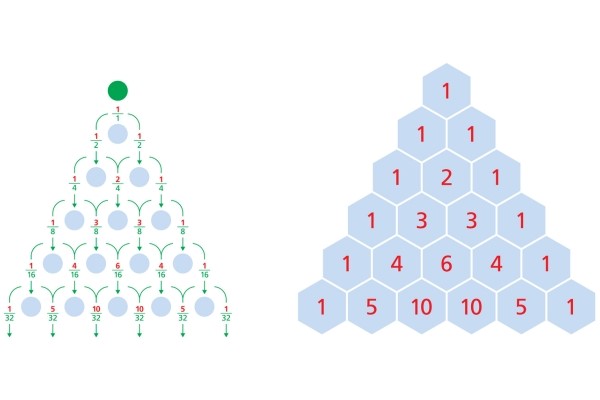
There’s so much to cover in a Finite Math course that it often feels like you’d need infinite time to see it all. But if you’re interested in the subject, here’s a brief look at its most common topics.
Logic
Logic assesses true and false statements. In a Finite Math course, rather than working with specific statements, you’ll often work with abstract ones represented by letters such as p and q .
Here are a few ways that p and q may appear in compound statements:
- ~ p (pronounced “not p”) has the opposite truth value of p .
- p ⋀ q (pronounced “ p and q ”) is true if both statements are true.
- p ⋁ q (pronounced “ p or q ”) is true if at least one of the two statements is true.
- p → q (pronounced “If p , then q ” or “ p implies q ”) is true unless p is true and q is false.
- p ↔︎ q (pronounced “ p if and only if q ”) is true if p and q have the same truth value.
These rules can be summarized in a truth table:
|
p |
q |
~ p |
p ⋀ q |
p ⋁ q |
p → q |
p ↔︎ q |
|
T |
T |
F |
T |
T |
T |
T |
|
T |
F |
F |
F |
T |
F |
F |
|
F |
T |
T |
F |
T |
T |
F |
|
F |
F |
T |
F |
F |
T |
T |
Set Theory
A set is a list without any repetitions. Much of Set Theory involves how different sets relate to each other. Here are some examples:
- Set A is a subset of Set B (denoted A ⊆ B) if every element of Set A is a member of Set B. Note that every set is a subset of itself.
- The union of Sets A and B (denoted A ∪ B) is the set of all elements that are in at least one of the two sets.
- The intersection of Sets A and B (denoted A ∩ B) is the set of all elements in both sets.
These ideas can be demonstrated in the table below:
|
A = {1, 2, 3} |
B = {3, 4} |
C = {1, 3, 4, 8} |
|||||||
|
A ⊆ A? |
A ⊆ B? |
A ⊆ C? |
B ⊆ A? |
B ⊆ B? |
B ⊆ C? |
C ⊆ A? |
C ⊆ B? |
C ⊆ C? |
|
|
YES |
NO |
NO |
NO |
YES |
YES |
NO |
NO |
YES |
|
|
A ∪ B |
A ∪ C |
B ∪ C |
|||||||
|
{1, 2, 3, 4} |
{1, 2, 3, 4, 8} |
{1, 3, 4, 8} |
|||||||
|
A ∩ B |
A ∩ C |
B ∩ C |
|||||||
|
{3} |
{1, 3} |
{3, 4} |
|||||||
Combinatorics
Combinatorics involves counting the different possible ways to make groups. There are two main ways of forming groups: permutations and combinations.
Use permutations when order matters. For example, if you are choosing class president, vice president, and treasurer from five students, you can find out the number of possible groups with simple multiplication:
5 × 4 × 3 = 60
Use combinations when order doesn’t matter. This time, you are assigning three identical student council positions from five students. You’ll start as if it’s a permutation, figuring out the number of possible groups, but then use some division to eliminate identical groups (like A B C and C B A).
5 x 4 x 33 x 2 x 1 = 10
Probability
The basic formula for probability (the likelihood that an event will take place) is:
Probability = number of outcomes fulfilling the requirementstotal number of possibile outcomes
Finite Math will include compound probability, the likelihood of two or more independent events occurring (or of one not occurring):
- The probability that both events will occur: P(A and B) = P(A) × P(B)
- The probability that either or both events will occur: P(A or B) = P(A) + P(B) – P(A and B)
- The probability that event A will not occur is P(not A) = 1 – P(A)
Vectors
A vector is a quantity that is assigned a (possibly multi-dimensional) direction.
A three-dimensional array can be represented as < a , b , c >, with a , b , and c each representing the distance travelled in one dimension. For each dimension, one direction is designated as positive with the opposite direction designated as negative. For example, if north, east, and up are positive, then the vector <3, –5, –2> can indicate a distance of 3 units to the north, 5 units to the west, and 2 units downward.
Matrices
Matrices have a wide variety of applications in fields like computing, chemistry, and quantum mechanics. Despite the complex applications, a matrix is a simple two-dimensional table. Here are some examples of what a matrix may look like:
In a Finite Math course, you can expect to learn about some basic operations, such as matrix addition, scalar multiplication, and matrix multiplication.
Statistics
Statistics is a way to measure lists of numbers in the various ways:
- Average (Arithmetic Mean): the sum of all elements in a list divided by the number of elements
- Median: the middle number in an ordered list
- Range: the difference between the greatest and the least element in a list
- Mode: the most frequently occurring number in a list
- Standard deviation: a measure of how far apart numbers in the list tend to be
A common thread across all these Finite Math topics is that you have to know how to read what you’re given—whether it’s a set, array, or matrix—and use the right tool for translating it, whether that’s finding an intersection, an if and only if, or a standard deviation. If you feel uneasy with any of these subjects, consider working through some sample problems with a tutor.
Explore Colleges For You
Connect with our featured colleges to find schools that both match your interests and are looking for students like you.
Get Started on Athletic Scholarships & Recruiting!
Join athletes who were discovered, recruited & often received scholarships after connecting with NCSA's 42,000 strong network of coaches.
Best 391 Colleges
170,000 students rate everything from their professors to their campus social scene.



